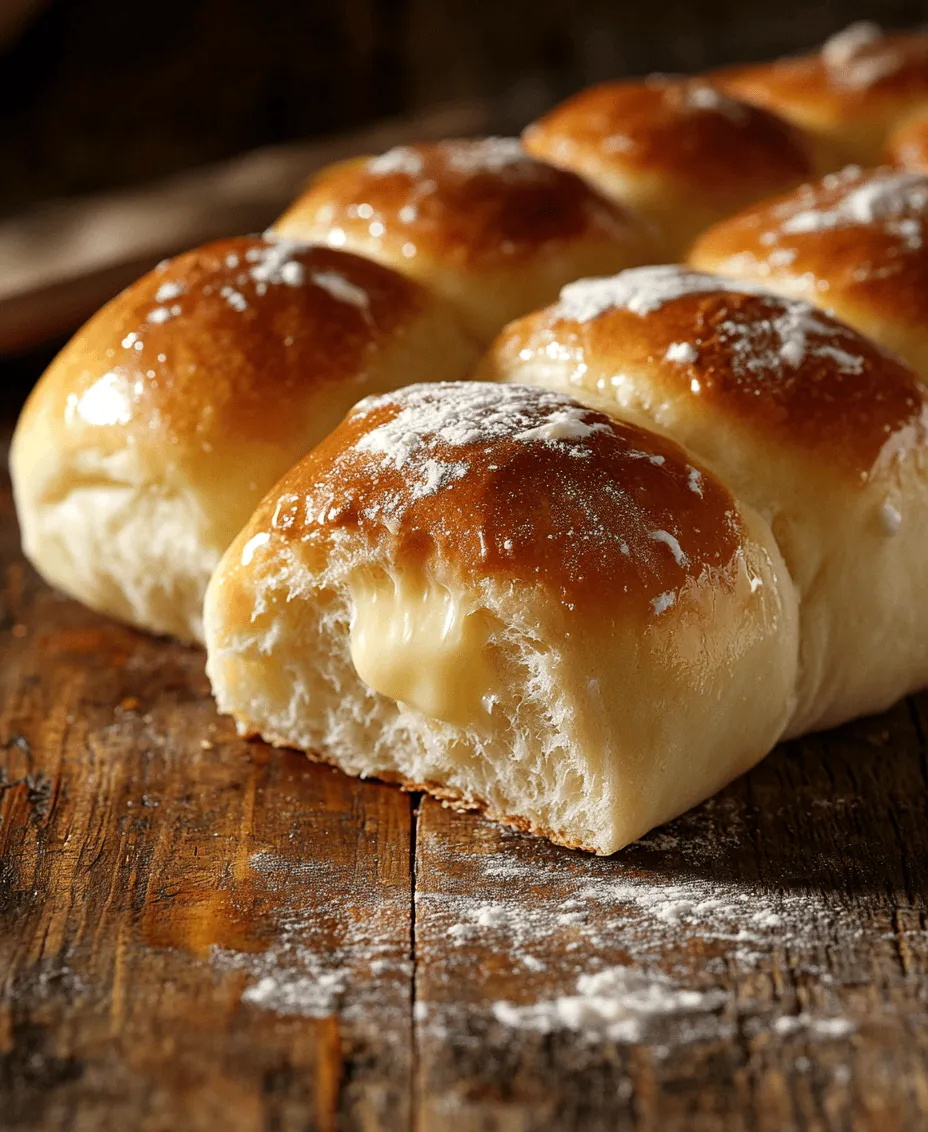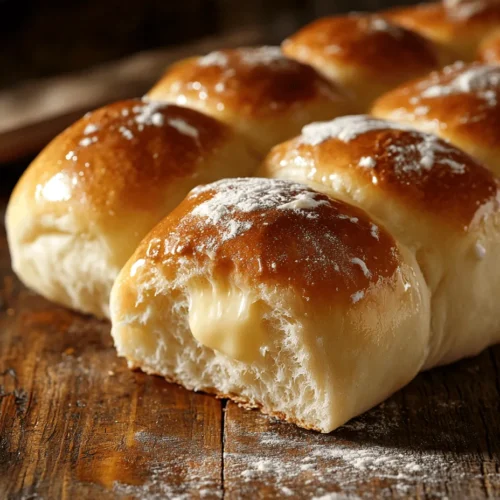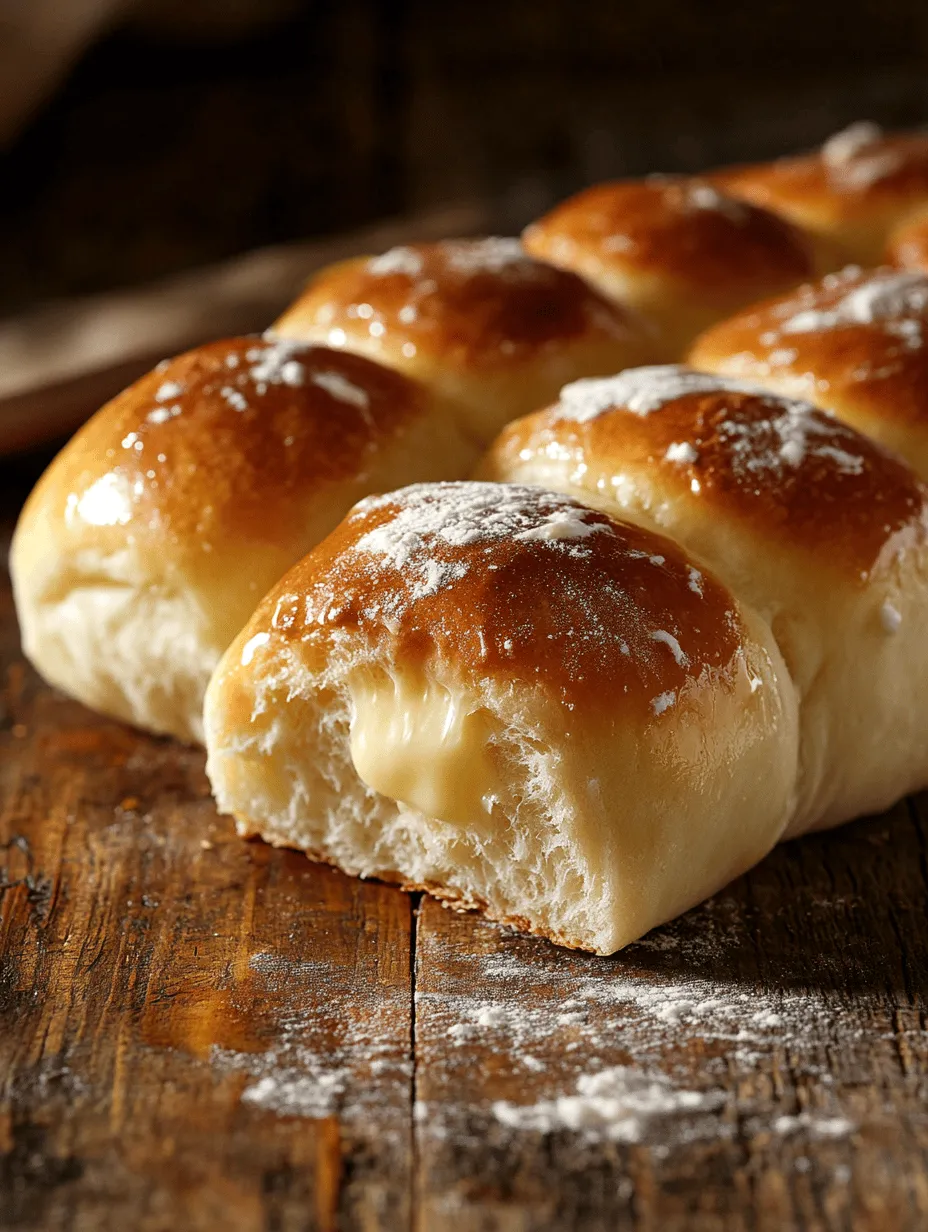Introduction
Dinner rolls hold a special place in culinary traditions around the world. Often gracing tables during holidays, family gatherings, or Sunday dinners, these soft, pillowy bread rolls are more than just a side dish—they are a symbol of comfort and togetherness. The delightful aroma of freshly baked rolls wafting through the kitchen can evoke cherished memories and bring a sense of warmth to any meal. Among the myriad of dinner roll recipes, the Heavenly Fluffy Buttery Dinner Rolls stand out for their exceptional texture and flavor, making them a must-try for any bread enthusiast.
This recipe for Heavenly Fluffy Buttery Dinner Rolls not only promises a delightful baking experience but also delivers rolls that are incredibly soft, buttery, and easy to prepare. Whether you’re a seasoned baker or a novice venturing into the world of yeast bread, this recipe simplifies the process while ensuring that you achieve rolls that are light as air and bursting with flavor. As you knead the dough and watch it rise, you’ll find joy in the transformative process of baking, leading to an irresistible final product that pairs beautifully with any meal.
What sets these dinner rolls apart? Their key features include an unparalleled fluffiness that melts in your mouth, a rich buttery flavor that elevates every bite, and an easy preparation method that makes them accessible to everyone. With just a few quality ingredients and some patience, you can create rolls that will impress your family and friends, making any meal feel like a celebration.
Understanding the Ingredients
To create these Heavenly Fluffy Buttery Dinner Rolls, it’s essential to understand the role of each ingredient in the recipe. The combination of these ingredients gives the rolls their unique texture, flavor, and overall appeal. Let’s break down the primary components:
All-Purpose Flour
All-purpose flour is the backbone of any bread recipe, providing the necessary structure and texture. Its moderate protein content strikes a balance between tenderness and chewiness, allowing the rolls to rise beautifully while maintaining a soft interior. When measuring flour, it’s crucial to spoon it into the measuring cup and level it off to avoid excess flour, which can lead to dense rolls.
Active Dry Yeast
Yeast is a living organism that plays a vital role in the leavening process. Active dry yeast, in particular, is a popular choice for home bakers because it is shelf-stable and easy to use. When activated in warm water or milk, yeast begins to ferment, producing carbon dioxide gas that causes the dough to rise. This fermentation process also contributes to the development of flavor, resulting in rolls that are not only fluffy but also rich in taste.
Granulated Sugar
Sugar is not just a sweetener in this recipe; it also aids in the activation of yeast. When combined with warm liquid, sugar feeds the yeast, encouraging it to grow and produce gas. Additionally, the slight sweetness balances the savory elements of the rolls, enhancing their overall flavor profile. It’s important to use the right amount of sugar—too much can lead to overly sweet rolls, while too little may hinder yeast activation.
Salt
Salt is a crucial ingredient in bread-making, serving multiple purposes. It enhances the flavor of the rolls and also regulates yeast activity. Without salt, yeast can become overly vigorous, leading to an unbalanced rise and an uneven texture. Additionally, salt strengthens the gluten structure, helping to create a chewy yet tender roll.
Whole Milk
Whole milk adds moisture and richness to the dough, contributing to the overall softness of the rolls. The fat content in whole milk creates a tender crumb and enhances the buttery flavor of the final product. Using warm milk in the dough helps activate the yeast while also making the dough easier to work with.
Unsalted Butter
Butter is the star ingredient that imparts a delightful richness and flavor to the rolls. Unsalted butter is preferred in baking as it allows you to control the salt content in the recipe. The fat in butter not only contributes to the rolls’ flavor but also helps to create a tender texture by coating the flour particles and inhibiting gluten formation.
Eggs
Eggs play a crucial role in enriching the dough and providing binding. They add moisture and contribute to the structure of the rolls, ensuring they hold their shape while baking. The proteins in eggs also help create a golden crust and improve the overall texture of the finished rolls.
Honey (Optional)
While honey is an optional ingredient, adding it to the dough can introduce a subtle complexity of flavor and an extra touch of sweetness. Honey also acts as a natural humectant, helping to retain moisture in the rolls, which can enhance their shelf life.
The Science Behind Perfect Dinner Rolls
Understanding the science behind the ingredients and techniques used in baking is key to achieving perfect dinner rolls. Each step in the process plays a significant role in determining the final outcome. Here’s a closer look at some of the essential concepts involved:
How Yeast Works and the Fermentation Process
Yeast fermentation is the process by which yeast consumes sugars and converts them into alcohol and carbon dioxide gas. This gas is what makes the dough rise. The initial activation of the yeast in warm liquid is crucial, as the ideal temperature encourages yeast activity. Typically, a temperature range of 100°F to 110°F is optimal for activating active dry yeast. As the dough ferments, the yeast continues to produce gas, causing the dough to expand and develop flavor.
Importance of Kneading Dough for Gluten Development
Kneading is an essential step in bread-making that helps develop gluten, the protein network that gives bread its structure. When you knead dough, you are aligning the gluten strands, which allows them to trap the gases produced by the yeast. This results in a light and airy texture. Proper kneading is achieved when the dough becomes smooth and elastic, typically taking about 8-10 minutes by hand or 5-7 minutes in a stand mixer.
The Significance of Proofing and Rising Times for Texture and Flavor
Proofing, or allowing the dough to rise, is critical for developing the final texture and flavor of the rolls. The first rise (bulk fermentation) allows the dough to expand as yeast continues to produce gas. After shaping the rolls, a second rise (proofing) is necessary for the rolls to reach their final volume before baking. Each rise should be done in a warm, draft-free environment, allowing the dough to approximately double in size—this can take anywhere from 1 to 2 hours for the first rise and about 30-45 minutes for the second rise.
Exploring the Maillard Reaction During Baking for the Golden Crust
As the rolls bake, they undergo a series of chemical reactions that contribute to their flavor and appearance. One of the most important is the Maillard reaction, which occurs when proteins and sugars in the dough react under heat, creating a golden-brown crust and enhancing the overall flavor. This reaction is what gives baked goods their characteristic aroma and enticing color. To achieve a perfect crust, it’s essential to bake the rolls at the right temperature and for the right amount of time, allowing them to develop that sought-after golden hue.
Step-by-Step Guide to Making Heavenly Fluffy Buttery Dinner Rolls
Now that we understand the significance of each ingredient and the science behind the baking process, it’s time to dive into the step-by-step guide for making these Heavenly Fluffy Buttery Dinner Rolls.
1. Gather Your Ingredients: Begin by assembling all the necessary ingredients: all-purpose flour, active dry yeast, granulated sugar, salt, whole milk, unsalted butter, eggs, and honey (if using).
2. Activate the Yeast: In a small bowl, combine the warm milk and a teaspoon of sugar. Sprinkle the active dry yeast over the top and let it sit for about 5-10 minutes until it becomes foamy. This indicates that the yeast is active and ready to use.
3. Mix the Dough: In a large mixing bowl, combine the remaining sugar, salt, and flour. Create a well in the center and add the activated yeast mixture, melted unsalted butter, eggs, and honey (if using). Stir until a shaggy dough forms.
4. Knead the Dough: Turn the dough out onto a floured surface and knead for about 8-10 minutes, or until it becomes smooth and elastic. Alternatively, use a stand mixer fitted with a dough hook to knead the dough for about 5-7 minutes.
5. First Rise: Transfer the kneaded dough to a greased bowl, cover it with a clean kitchen towel or plastic wrap, and place it in a warm, draft-free area. Allow it to rise for about 1 to 2 hours, or until doubled in size.
6. Shape the Rolls: Once the dough has risen, punch it down to release the gas. Turn it out onto a floured surface and divide it into equal portions (typically, this recipe yields about 12-15 rolls). Shape each portion into a ball and place them in a greased baking dish, leaving some space between each roll.
7. Second Rise: Cover the shaped rolls again with a kitchen towel or plastic wrap and let them rise for an additional 30-45 minutes, or until they have puffed up and filled the gaps in the baking dish.
8. Preheat the Oven: While the rolls are undergoing their second rise, preheat your oven to 350°F (175°C). This ensures that the oven is hot and ready for baking as soon as the rolls have risen.
By following these initial steps, you are well on your way to creating a batch of Heavenly Fluffy Buttery Dinner Rolls that will impress everyone at the dinner table. The next part of this article will delve into the baking process, tips for achieving the perfect finish, and answers to common questions about making dinner rolls. Stay tuned for a delicious conclusion to your baking journey!

Detailed Breakdown of the Preparation Process
To create Heavenly Fluffy Buttery Dinner Rolls, each step of the preparation process is crucial in achieving that perfect balance of fluffiness and buttery goodness. This section will guide you through each stage, ensuring your rolls turn out soft, light, and utterly delicious.
Preparing the Yeast Mixture: Importance of Temperature and Timing
The yeast mixture is the foundation of your dinner rolls. Start by measuring 1 packet (about 2 ¼ teaspoons) of active dry yeast and combining it with 1 cup of warm water (about 110°F or 43°C). It’s essential to use water that is warm but not hot; temperatures above 130°F (54°C) can kill the yeast, while water that is too cold may not activate it properly. Add a teaspoon of sugar to the mixture to feed the yeast. Allow it to sit for about 5 to 10 minutes until it becomes frothy and bubbly. This bubbling action indicates that the yeast is active and ready to work its magic in your dough.
Combining Ingredients: Tips for Achieving the Right Dough Consistency
Once your yeast mixture is ready, it’s time to combine it with the other ingredients. In a large mixing bowl, combine 3 cups of all-purpose flour, ¼ cup of granulated sugar, and 1 teaspoon of salt. Make a well in the center and pour in your yeast mixture along with ¼ cup of melted unsalted butter and 1 large egg. Using a wooden spoon or spatula, gently stir the mixture until it starts to come together. At this point, you may need to add more flour, a little at a time, until the dough forms a sticky ball that pulls away from the sides of the bowl. The dough should be tacky but not overly sticky.
Kneading: Techniques for Effective Kneading and Dough Development
Kneading is critical to developing the gluten in your dough, which gives the rolls their structure and chewy texture. Transfer the dough to a lightly floured surface and knead it by pushing it down and away from you with the heel of your hand, then folding it back over itself. Rotate the dough a quarter turn and repeat the kneading process for about 8 to 10 minutes. You’ll know the dough is ready when it feels smooth and elastic, and springs back when poked. If the dough is too sticky, sprinkle a little flour on your surface, but be cautious not to add too much, as it can make the rolls dense.
First Rise: Optimal Conditions for Dough Rising
After kneading, place the dough in a greased bowl, turning it to coat the surface with oil. Cover the bowl with a clean kitchen towel or plastic wrap to retain moisture. Set the bowl in a warm, draft-free area to rise until it has doubled in size, which typically takes about 1 to 1.5 hours. An ideal spot is in an oven turned off but with the light on or near a warm window. This first rise is essential for developing flavor and texture in your rolls, so be patient and let the dough rise fully.
Shaping the Rolls: Instructions on Dividing and Shaping Dough into Balls
Once your dough has risen, punch it down gently to release the air. Turn it out onto a floured surface and divide it into 12 equal pieces using a bench scraper or a knife. To shape each piece into a roll, pull the edges of the dough towards the center, pinching them to seal, then flip it over and roll it gently against the surface to create a smooth ball. Place each ball seam-side down into a greased 9×13 inch baking dish, arranging them close together to encourage rising and soft sides.
Second Rise: Importance of Patience for Fluffiness
Cover the shaped rolls with a towel or plastic wrap again, allowing them to rise for an additional 30 minutes to 1 hour. This second rise is crucial for achieving that fluffy texture. As they rise, the rolls will expand and fill in the gaps between them, resulting in a tender, pull-apart texture once baked. Ensure they are in a warm environment, similar to the first rise, to promote yeast activity.
Baking: Setting the Right Temperature and Time for Perfect Rolls
Preheat your oven to 375°F (190°C) during the last 15 minutes of the second rise. Once the rolls have puffed up nicely, bake them in the preheated oven for 20 to 25 minutes, or until they are golden brown on top. To enhance the flavor and give them a beautiful shine, brush the tops with melted butter immediately after removing them from the oven. Let the rolls cool in the pan for about 5 minutes before transferring them to a wire rack to cool completely.
Serving Suggestions and Pairings
Heavenly Fluffy Buttery Dinner Rolls are incredibly versatile and can elevate any meal. Here are some delightful serving suggestions to consider:
– As a Side for Soups and Stews: These rolls are perfect for sopping up hearty soups and stews. Their fluffy texture makes them ideal for soaking up flavorful broths, ensuring no drop of soup goes uneaten.
– Pairing with Salads and Main Courses: Serve these rolls alongside fresh salads or as a companion to roasted meats and vegetables. Their buttery flavor complements a variety of dishes, making them a perfect addition to your dinner table.
– Use as a Base for Sliders or Sandwiches: These rolls can also be sliced and filled with your favorite sandwich fillings. Whether it’s a classic ham and cheese or a gourmet pulled pork slider, the rolls provide a soft yet sturdy base that holds up well.
The Joy of Homemade Bread
Baking bread, especially dinner rolls, is more than just a task; it’s a sensory experience that engages the heart and soul. The aroma of freshly baked bread wafting through your home can evoke feelings of warmth and comfort, creating an inviting atmosphere. The tactile experience of kneading the dough is therapeutic, allowing you to connect with the ingredients and the process.
Sharing homemade rolls with family and friends brings a sense of joy and accomplishment. There’s something special about presenting a basket of warm, fluffy rolls at the dinner table, knowing you crafted them from scratch. It invites conversation, laughter, and a sense of togetherness. Don’t be afraid to experiment with variations on this basic recipe. You can add herbs, cheese, or spices to the dough to create unique flavors that cater to your personal taste.
Conclusion
In recap, the process of making Heavenly Fluffy Buttery Dinner Rolls is rewarding and fulfilling. From preparing the yeast mixture to the final baking, each step contributes to the overall success of the recipe. The joy of baking these rolls is not only about the delicious result but also the experience of creating something from scratch that brings people together.
I encourage you to try making these rolls for yourself. Whether it’s for a special occasion or a simple family dinner, these rolls are sure to impress. Homemade bread is an integral part of creating memorable meals, and with this recipe, you can bring the warmth and comfort of freshly baked rolls into your kitchen. So roll up your sleeves, gather your ingredients, and start baking today!


